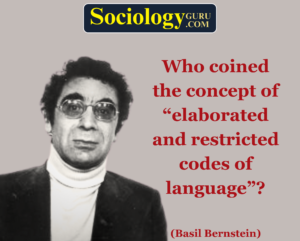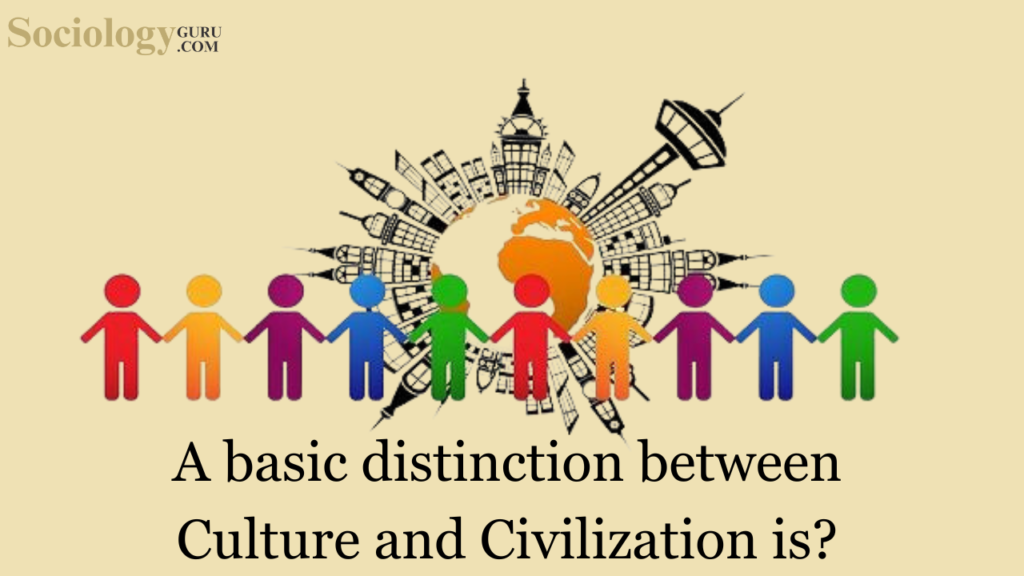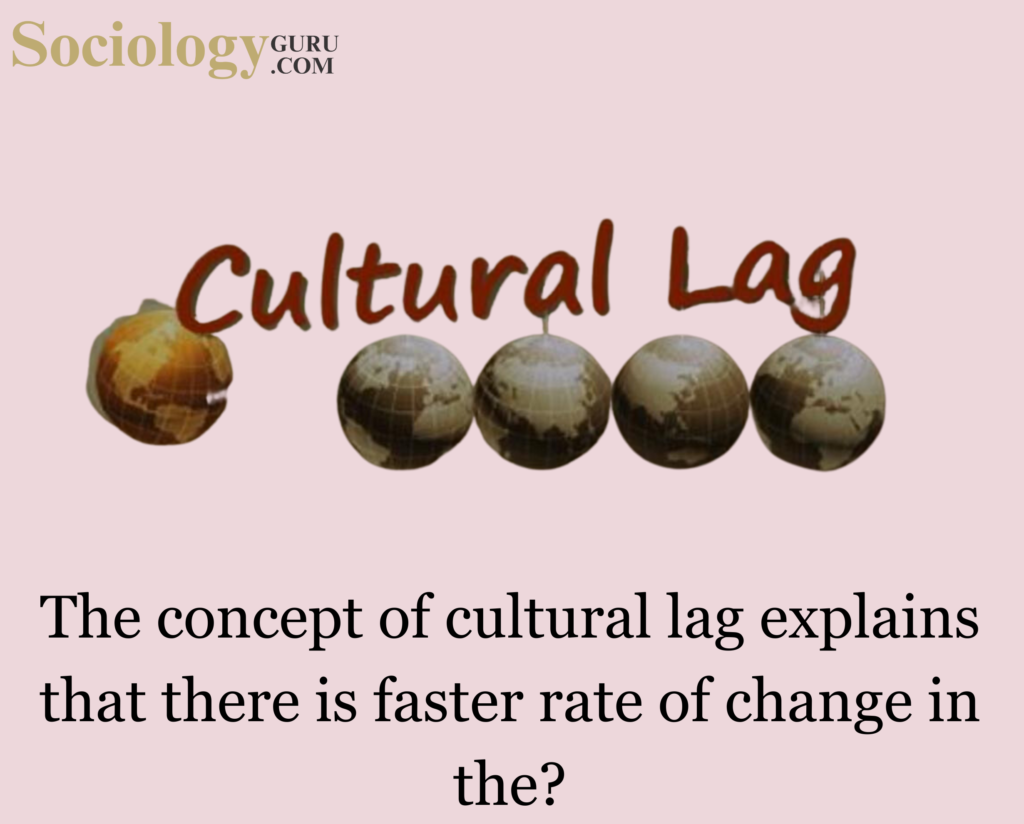Question: Who coined the concept of “elaborated and restricted codes of language”?
- Cehomsky
- Skinner
- Bernstein
- Berreman
Answer: (3)The concept of “elaborated and restricted codes of language” was coined by the British sociologist Basil Bernstein in the 1960s. This concept forms a crucial part of Bernstein’s general theory on the nature of social systems and social rules, particularly in the context of language use. The options provided in the MA CUET exam question were (a) Chomsky, (b) Skinner, (c) Bernstein, and (d) Berreman, and the correct answer is (c) Bernstein. Bernstein’s theory introduces the idea of two distinct varieties or codes of language use: the elaborated code and the restricted code. These codes are seen as tools for communication within different social contexts, shedding light on how language is utilized across various situations and settings. Elaborated Code:The elaborated code is characterized by its use in relatively formal and educated situations. In these contexts, individuals employing the elaborated code have the freedom to express themselves creatively and use a wide range of linguistic alternatives. Linguistically, the elaborated code is marked by features such as subordinate clauses, adjectives, the pronoun “I,” and passive constructions. This code allows for a more nuanced and varied expression of ideas. Restricted Code:In contrast, the restricted code is utilized in relatively informal situations. It emphasizes the speaker’s membership in a specific group and relies heavily on context for meaningful communication. Linguistically, the restricted code is highly predictable, with a significant use of pronouns, tag questions, and reliance on non-verbal communication such as gestures and intonation to convey meaning. The restricted code lacks the stylistic range found in the elaborated code. Bernstein’s theory also attempted to correlate these codes with specific social class backgrounds. The idea was to explore whether individuals from different social classes predominantly used one code over the other. This exploration led to the theory gaining considerable attention and sparking controversy, particularly in educational settings. In educational contexts, Bernstein’s theory raised questions about the role of these codes in determining academic success. For instance, it considered whether children who were accustomed to using the restricted code would face challenges in educational environments where the elaborated code is the norm. This aspect of the theory brought attention to potential disparities in communication styles and their impact on academic performance, contributing to discussions on language and social class in educational research. The attempt to link language codes with social class backgrounds sparked debates on issues of equality, access to education, and the role of language in perpetuating or challenging social hierarchies. Critics argued that such theories could lead to stereotypes and reinforce existing inequalities, while proponents saw value in understanding how language patterns might influence educational outcomes. Basil Bernstein’s work on elaborated and restricted codes of language has left a lasting impact on the fields of sociology and education. It not only provided a framework for understanding language variation in different social contexts but also prompted researchers and educators to consider the implications of linguistic diversity in educational settings. The controversy surrounding the theory underscores the importance of critically examining the intersection of language, social structures, and education. In summary, the concept of elaborated and restricted codes of language, introduced by Basil Bernstein, has significantly contributed to our understanding of how language functions as a social tool and the role it plays in shaping various aspects of society, including education. |
Take a Quick Sociology Quiz to measure your Performance
Frequently Asked Questions:
1. Question: Define the term “ethnic movement” and provide an example from India.
Answer: An ethnic movement refers to a collective effort by a group sharing common cultural, linguistic, or religious traits, seeking to assert their identity and rights; an example from India is the Khalistan Movement in Punjab.
2. Question: Identify the main objectives behind the Gorkhaland ethnic movement.
Answer: The Gorkhaland ethnic movement primarily seeks to establish a separate state for India’s Nepali-speaking population in the Darjeeling region, advocating for linguistic and cultural recognition and political autonomy.
3. Question: What was the Operation Blue Star, and which ethnic movement was it related to?
Answer: Operation Blue Star was a military action in 1984, aiming to remove Sikh militants hiding in the Golden Temple in Amritsar; it is related to the Khalistan movement, which sought a separate Sikh country.
4. Question: Mention a critical factor that triggered the emergence of ethnic movements in India, as discussed by Dipankar Gupta.
Answer: Dipankar Gupta emphasized that ethnicity is fundamentally a political process, wherein caste and religion, the key components of identity formation, are politicized by leaders for vested interests.
5. Question: What were the primary reasons for the Assam Ethnicity conflicts involving Bodo tribals and Bengali Muslim settlers?
Answer: The Assam Ethnicity conflicts primarily stemmed from issues related to immigration, land rights, and resource allocation, leading to clashes, riots, and evolving relationships among indigenous communities to address challenges.
6. Question: Briefly describe the role of the Dravidian Movement in terms of caste and societal structure.
Answer: The Dravidian Movement, led notably by E.V. Ramasamy, aimed to establish an egalitarian society, focusing on anti-Brahmanism and advocating for equal rights for backward castes, while also introducing reforms like self-respect marriages.
7. Question: Name the prominent ethnic movements in North-East India and specify one common objective.
Answer: Prominent ethnic movements in North-East India include the Nagas’ and Mizos’ struggles; a common objective was to gain autonomy and recognition for their distinct tribal identities and cultural uniqueness.
8. Question: What is the key argument of Gail Omveldt regarding traditional Indian society and multiculturalism?
Answer: Gail Omveldt opposed romanticizing traditional Indian society, arguing that hierarchy has always dominated it and dismissing the notion that multiculturalism is an intrinsic feature of Indian society as a myth.
9. Question: Briefly explain the social hierarchy factor as a contributing element to ethnic movements as suggested by Olzak.
Answer: Olzak suggests that the construction of hierarchies among ethnic communities, which often leads to the suppression of one group by another, is a key factor that can instigate social and ethnic movements.
10. Question: Identify one consequence of the unequal economic development factor within the context of ethnic movements in India.
Answer: One consequence of unequal economic development is the marginalization and underdevelopment of certain groups, leading to feelings of alienation and sometimes initiating ethnic movements as these groups strive for equality and recognition.
To master these intricacies and fare well in the Sociology Syllabus, aspiring sociologists might benefit from guidance by the Best Sociology Teacher and participation in the Best Sociology Coaching. These avenues provide comprehensive assistance, ensuring a solid understanding of sociology’s diverse methodologies and techniques.
META TAGS:
Why Vikash Ranjan’s Classes for Sociology?
Proper guidance and assistance are required to learn the skill of interlinking current happenings with the conventional topics. VIKASH RANJAN SIR at SOCIOLOGY GURU guides students according to the Recent Trends, making him the Best Sociology Teacher for Sociology.
At Sociology Guru, the Best Sociology Coaching platform, we not only provide the best study material and applied classes for Sociology but also conduct regular assignments and class tests to assess candidates’ writing skills and understanding of the subject.
Choose The Best Sociology Teacher for your Preparation?
To master these intricacies and fare well in the Sociology Syllabus, aspiring sociologists might benefit from guidance by the Best Sociology Teacher and participation in the Best Sociology Coaching. These avenues provide comprehensive assistance, ensuring a solid understanding of sociology’s diverse methodologies and techniques. Sociology, Social theory, Best Sociology Teacher, Best Sociology Coaching, Sociology Syllabus.
Best Sociology Teacher, Sociology Syllabus, Sociology, Sociology Coaching, Best Sociology Coaching, Best Sociology Teacher, Sociology Course, Sociology Teacher, Sociology Foundation, Sociology Foundation Course, Sociology CUET, Sociology for IAS, Sociology for UPSC, Sociology for BPSC, Sociology for UGC NET, Sociology for JPSC,
Follow us :
KEYWORD:-Elaborated and Restricted, Elaborated and Restricted, Elaborated and Restricted, Elaborated and Restricted, Elaborated and Restricted, Elaborated and Restricted, Elaborated and Restricted, Elaborated and Restricted, Elaborated and Restricted, Elaborated and Restricted, Elaborated and Restricted, MA CUET SOCIOLOGY



